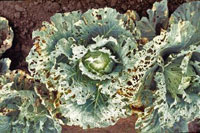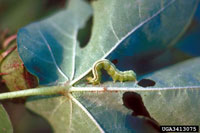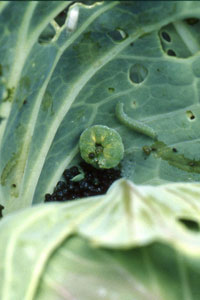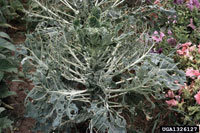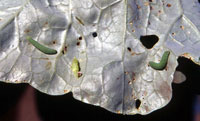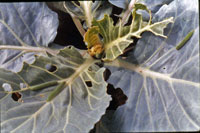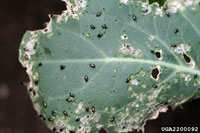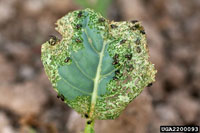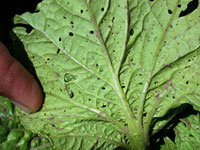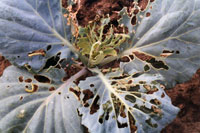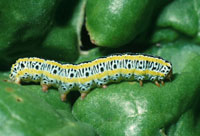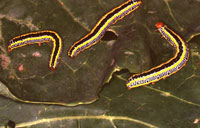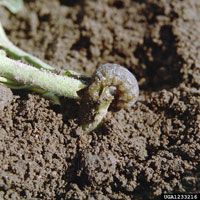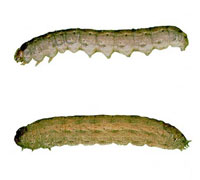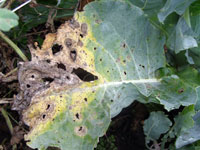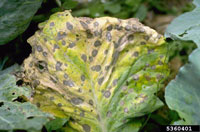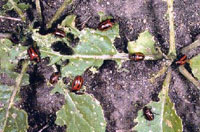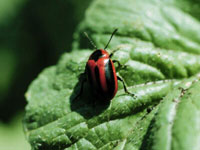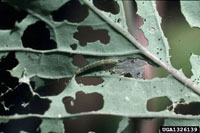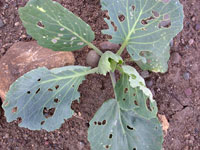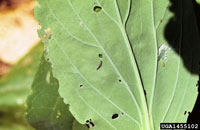Extension > Garden > Diagnose a problem > What's wrong with my plant? > Vegetable > Cauliflower > Holes in leaves
Cauliflower > Leaves > Holes in leaves
1 of 8
Cabbage Looper
Trichoplusia ni
- Larvae feed on leaves resulting in large ragged holes
- Severely defoliated plants may not form a head
- Dark green larva excrement may be present
- Larvae are up to 1 ½ inches in length, light green, and move in a characteristic “looping” action
- Present from early July to late August
- More information on Cabbage Looper
2 of 8
Imported Cabbageworm
Artogeia rapae
- Larvae feed on leaves causing irregularly shaped holes
- Larvae are up to 1 inch in length, velvety green in color with faint yellow stripes running longitudinally on the back and sides
- Larvae are present throughout the growing season
- Brown larva excrement may be present
- More information on Imported Cabbageworm
3 of 8
Flea Beetle
Phyllotreta spp.
- Adult feeding on leaves creates shallow pits and small, irregular holes giving it a “shot hole” appearance
- Plants appear wilted
- Plants may be stunted
- Adults are small (1/16 to 1/8 inch long), and vary in color; all have enlarged back legs
- Present throughout the season, young plants more susceptible
- More information on Flea Beetle
4 of 8
Zebra Caterpillar
Melanchra picta
- Feed on leaves, can defoliate entire plant
- Caterpillar is black with yellow longitudinal stripes on both sides
- Present in early summer and again in late summer
- More information on Zebra Caterpillar
5 of 8
Cutworms (climbing and non-climbing)
- Plant is cut off at or just below the soil surface
- Can chew holes in leaves (spring and early summer)
- Can cause “blindness”, in which no head develops
- Cutworms are grayish or brownish and up to 2 inches long; typically found during day hiding in soil
- Damage occurs during spring and summer
- More information on Cutworms
6 of 8
Black Leaf Spot/Gray Leaf Spot
Alternaria spp.
- Gray to black round leaf spots with concentric rings
- Leaf tissue becomes dry, brittle and often falls out, resulting in a ‘shot hole’ appearance
- Leaf spots often appear first on lower older leaves
- Broccoli and cauliflower heads may develop dark brown irregular sunken areas
- More information on Leaf Spot
7 of 8
Red Turnip Beetle
Entomoscelis americana
- Adults feed on leaves, and can defoliate entire plant
- Plants may be stunted
- Adult is ½ inch long, red with three black strips that run longitudinally down its back
- More information on Red Turnip Beetle
8 of 8
Diamondback Moth
Plutella xylostella
- Affected tissue eventually falls out resulting in small holes
- Larvae feed on leaves, turning tissue opaque/white color
- Larvae feed on developing heads which can cause deformities
- Larvae are up to 1/3 inch and pale green in color
- Present throughout the growing season
- More information on Diamondback Moth



